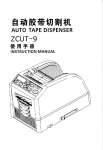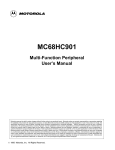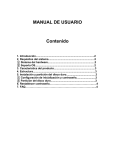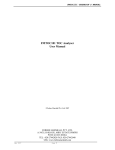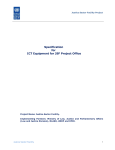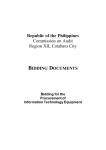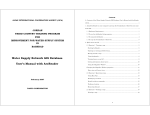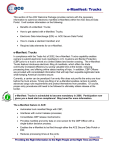Download IDMS Standard Operating Procedures
Transcript
Iraq Development Management System (IDMS) Standard Operating Procedures for Donor Data Entry 2 August 2010 Produced by the Ministry of Planning (MoP), International Cooperation Directorate (ICD), Release: 2 August 2010 1/9 IDMS Standard Operating Procedures: Ensuring IDMS captures your agency’s contribution The purpose of this Standard Operating Procedure (SOP) is to establish sustainable cooperation between the Government of Iraq and donor agencies by sharing information on assistance in order to improve aid effectiveness. This document explains the role of IDMS as an aid management tool and how to update it. It is aimed at donor agencies, which have the primary responsibility to update project information on a quarterly basis. A. What is IDMS and why is it important? The Iraq Development Management System (IDMS) is a bi-lingual web-based aid information management system, owned and hosted by the Ministry of Planning (MoP). Under Regulation 7 of the Coalition Provisional Authority (CPA) of Iraq, MoP is mandated to undertake necessary actions under its own discretion to promote, allocate, and follow up on international assistance. Donor aid to Iraq has been unprecedented in size and scale with committed grant assistance alone in excess of $23 billon in the period 2003-2007. In addition, the multiplicity of actors involved in Iraq (including UN agencies, bilateral donors and NGOs) and the complex operating environment present significant problems for effective aid management. IDMS helps to restore control of development to the Government of Iraq by providing a consolidated repository of aid information aligned with government systems. Some of the key benefits of IDMS for aid effectiveness are: 1. Enhanced Transparency: enables Government to track aid flows and activities funded by multilateral and bilateral agencies in addition to national budget programmes to provide a holistic multi-year picture of development in Iraq. Publicly-available online reporting presents information on the status of aid activities. 2. Improved Planning: informs integrated planning of development initiatives and resource allocation, helps to identify funding gaps against national strategy as well as minimise overlaps in implementation. 3. Managing for Results: keeps donors aware of their commitment calendars, tracks disbursements and monitors results. IDMS (publicly accessible through the MoP website: http://www.mop-iraq.org/idms) is the only source of consolidated information on development projects in Iraq. To date, IDMS contains information on 17,489 grant assistance projects implemented in Iraq with the support of donor countries and multi-lateral institutions since 2003. The total amount of committed assistance, as recorded in the External Assistance Application of IDMS, is US$ 15.6 billion, representing 70% of the total. However, IDMS’s utility as a tool for effective aid management is dependent on the completeness, accuracy and timeliness of the information provided. Produced by the Ministry of Planning (MoP), International Cooperation Directorate (ICD), Release: 2 August 2010 2/9 B. Who should update IDMS? All organisations involved in the Iraqi reconstruction and development process should check to see that IDMS has captured your contribution. This includes donors, United Nations agencies, International Financial Institutions, international and national NGOs. IDMS tracks aid by individual project, defined as an activity or a set of activities and defined outputs, usually in pursuit of a certain goal, with clearly defined start and end dates, source of funding and budget/project cost. IDMS distinguishes between two roles for organizations involved in projects: donors and implementers (see figure 1 below). Note that in some cases the donor and the implementer can be the same organisation, e.g. if a UN agency project is funded from its own core resources. Donor(s) Implementer Donor: originator of funding for project. May be bilateral, UN own resources, IFI, NGO own resources, private contribution, private sector firm. Implementer: the organisation that receives funding for a project and which is responsible for its implementation or for supervising implementation by a second level partner or contractor. May be a Government ministry or agency, the implementing wing of bilateral agency (e.g. SIDA), UN agency, IFI, private sector firm, international or national NGO. IMPORTANT: Donor Agencies have the primary responsibility for entering projects and updating information in IDMS. In the case of co-funded projects, donor agencies must select a leading agency to update IDMS. As an exception, implementing agencies and even executing agencies can also update the database, if the donor agency of the project agrees and assigns responsibility accordingly. The IRFFI Secretariat, in conjunction with MoP, are responsible for updating projects funded by the UNDG and World Bank Trust Funds (please also see the section on “How to Report Donor Contributions to Trust Funds” below). To facilitate entering and updating project information into IDMS, each donor is requested to nominate an Information Provider (IP) within their organisation. This person will serve as a focal point for communication with the MoP International Cooperation Directorate (ICD) team, who manage IDMS. The IP will be responsible for adding and updating projects to ensure their agency’s contribution is reflected. Produced by the Ministry of Planning (MoP), International Cooperation Directorate (ICD), Release: 2 August 2010 3/9 D. When should you update IDMS? There are three stages when data entry is required to ensure that IDMS contains up to date, accurate information. These are when the project is approved, quarterly progress updates and when the project finished: 1. New Project: enter new project information into IDMS once the project has been approved. This is the most time-consuming period of data entry but completing in a timely manner is essential for planning purposes. Before entering a new project, check very carefully whether or not IDMS already contains the project to avoid double counting. To do this, you should check under the donor agency’s name and also the implementer’s name to see if the project has already been recorded, as follows: 1. Make sure that you are in the “List” tab of the “External Assistance” application. N.B. this is the default view when you log in to IDMS. 2. Select “Projects listed by Donor” from the “Public Views” list on the left hand side. Click on the + button next to the name of the project donor to view a list of their projects. 3. Select “Projects listed by Implementer” from the “Public Views” list on the left hand side. Click on the + button next to the name of the project implementer to view a list of their projects. If the project already exists, please do not add a duplicate copy but rather update the existing project. Please contact the donor agency and the MoP team if you are unsure whose responsibility this is. If the project does not exist in the database, the donor agency should enter it as a new project record and share this information with the implementer(s) and the other funding agency(ies), if any. 2. Update Project: IP should review their project information on a quarterly basis to ensure that information is complete and up to date. This typically includes updating project progress, disbursements and any changes to expected project costs and overall delivery. 3. Close Project: finalise project information when the project comes to an end. This typically includes adding any final disbursements and changing implementation status to "completed". Produced by the Ministry of Planning (MoP), International Cooperation Directorate (ICD), Release: 2 August 2010 4/9 C. How to update IDMS The Information Provider can request a user account on-line via the link on the http://www.mop-iraq.org/idms log-in screen. When you have provided the name, title, telephone and email address for your agency’s Information Provider, you will receive a secure user name and password. This user name and password gives your Information Provider the rights and ability to edit data in IDMS that relates to your agency (and your agency only). Please contact [email protected] if you require assistance. The “External Assistance” application in IDMS holds information on all the projects that are implemented through external funding. Information Providers may choose to provide information on their respective projects either by directly entering information online through the inbuilt Data Entry Module or, if this is not possible, by providing information indirectly to the MoP team: a. On-line submission (preferred option) through the Web-based IDMS: http://www.mop-iraq.org/idms b. Off-line submission via word or excel spreadsheet: http://www.mopiraq.org/MoP/index.jsp?sid=1&id=260&pid=128. Adhere to the IDMS Project fields therein. N.B. Please see the “User Manual for External Assistance Data Entry” for detailed steps on completing the online data entry process (available from the IDMS homepage). Three IPs have direct online access to IDMS so far: SIDA on behalf of Sweden, CIDA on behalf of Canada and DFID on behalf of UK. Please see the detailed steps on data entry contained in the annex for further guidance. E. What information is required? The required information in the data entry process is split into four categories: 1. Project Details: containing general information on the project such as title, start date, end date, approval status, implementation status, progress (%), type of project, type of assistance, recipient and contact information. 2. Project Funding: containing financial information on the project such as project cost by year, by sector, by location and by type as well as donor commitments and disbursements over time and any government co-financing arrangements. 3. Project Outputs: containing information on the outputs of the project including beneficiaries and factors causing delay. 4. Notes and Attachments: where additional project documents and other background information can be uploaded. Produced by the Ministry of Planning (MoP), International Cooperation Directorate (ICD), Release: 2 August 2010 5/9 F. How to Report Donor Contributions to Trust Funds As data entered in IDMS is project-specific, Information Providers need an option for reporting funds channelled through one of the Trust Funds (e.g. the two IRFFI funds: UNDG and WB Trust Fund). Trust Funds represent pooled funding by multiple bilateral donors to different projects. Therefore it is impossible to track whose funds are used for which project, and the direct linkage between bilateral donors and projects is lost. For this reason, the “Donor Profiles” application was added to IDMS. It records the consolidated contributions of donors through different Trust Funds and bilaterally. Even though bilateral institutions do not appear as the direct donors of Trust Fund projects, through the Donor Profiles application their contribution is still recorded in IDMS at the donor level (a level higher than the project). This data has been collected by MoP from numerous sources, including the IRFFI web-site (www.irffi.org), and entered into the IDMS as a baseline for tracking the financial commitments and pledges of donors. Information Providers should verify accuracy and update their donor profile quarterly as per the external assistance application. Please see the “User Manual for Donor Profile Data Entry” for detailed guidance on how to update your Donor Profile, available from the IDMS homepage. G. Support and resources The International Cooperation Directorate (ICD) of the MoP manages IDMS on behalf of the Government of Iraq (GoI). The ICD team is responsible for: o providing support and training to users to enter new projects and update project information in IDMS o entering project information and data updates received off-line from IPs o data management to monitor quality and completeness of data in IDMS o disseminating regular analytical reports based on the data in IDMS to support planning and aid effectiveness Contact the IDMS administrator: Mr. Saif Hassan, [email protected] to organise training by MoP and UNDP Iraq. Core training is for Information Providers (IPs) and will cover how to update IDMS. Training can also be delivered via teleconference facility. In 2008, regular trainings will be planned for implementation in the IZ, Baghdad in the premises of MoP. Visit the MoP web-portal at www.mop-iraq.org/mop or contact the above mentioned focal points for more details on the schedule. In addition, there are a number of technical guides and manuals available, which you can take advantage of to make full use of IDMS and update your data. These are all available from the IDMS front page: www.mop-iraq.org/idms. Produced by the Ministry of Planning (MoP), International Cooperation Directorate (ICD), Release: 2 August 2010 6/9 User guides: 1. IDMS Handbook: explains the basic concepts of IDMS. 2. Analytics User Manual: describe how IDMS functions and provides instructions which the user should follow to ensure successful work. Data entry manuals: 1. “External Assistance Projects” application, online data entry: for use by donors and GoI to add and update externally financed projects. 2. “Donor Profile” application, online data entry: for use by donors and GoI to add and update donor profile information in IDMS. 3. “Capital Investment Projects” application, online data entry: for use by GoI ministries to add and monitor capital investment projects financed out of the national budget. 4. “Iraq Development Projects” application, online data entry: for use by GoI ministries to identify priority projects that are ready for implementation once appropriate funding is made available. H. Non Compliance MoP will produce a quarterly report measuring the completeness and accuracy of data and publish it on the MoP Web Portal (http://www.mop-iraq.org/mop). Agencies that do not update their information will be listed and their data will remain out of date in reports and publications. To assist compliance, e-mail notifications will be sent out to IPs on a quarterly basis, notifying them of projects that need to be updated. This will help to streamline the workflow process and allow all stakeholders to utilize the IDMS more effectively. I. Definition of Terms Key terms used in IDMS are defined below: General Definitions: Project: Activity or a set of activities and defined outputs, usually in pursuit of a certain goal, with clearly defined start and end dates, source of funding and budget/project cost. Donor: the agency that is the source of funds for the project. Implementer: the organisation that receives funds from the donor to implement the project. Recipient: the Government agency, civil society or private sector institution of the aid recipient country to which the ownership of the project outputs is to be transferred. Beneficiary: the Government agency, civil society or private sector institution of the aid recipient country, which benefits from the implementation of the project. Produced by the Ministry of Planning (MoP), International Cooperation Directorate (ICD), Release: 2 August 2010 7/9 Financial Definitions: Pledge: the grant or loan resources promised by a donor to Iraq over one year or a fixed number of years. Project Cost: the expected total amount required for the implementation of the project. In the case of multi-year projects, the project cost may be respectively distributed, reflecting the planned implementation/delivery of the project activities each year. Commitment: a firm obligation expressed in writing by the donor to the implementer for a particular project that is backed by the availability of the necessary funds or resources. Multiple commitments may be distributed throughout the duration of the project but the total sum of commitments should not exceed the total cost of the project. Commitment date: the date of the written agreement committing donor funds or resources to the implementing organisation. Disbursement: the placement of resources at the disposal of the implementing partner (UN agency, government, NGO, private sector etc.). Usually this involves the transfer of funds into the implementer’s bank account or the draw down by the implementer of funds held in an account by the donor. Disbursement Date: the date at which resources were actually transferred from donor to implementer. Other Definitions can be www.mop-iraq.org/idms. found in IDMS User handbook and manual Produced by the Ministry of Planning (MoP), International Cooperation Directorate (ICD), Release: 2 August 2010 at 8/9 J. Glossary CIDA: Canadian International Development Agency CPA: Coalition Provisional Authority DFID: Department for International Development EC: European Commission GoI: Government of Iraq ICD: International Cooperation Directorate, MoP IDMS: Iraq Development Management System IFI: International Financial Institution IM: Information Manager IP: Information Provider IRFFI: International Reconstruction Fund Facility for Iraq ISRB: Iraqi Strategic Review Board JICA: Japanese International Cooperation Agency MoP: Ministry of Planning NGO: Non-Governmental Organization PIU: Project Implementation Unit SIDA: Swedish International Development Cooperation Agency SOP: Standard Operating Procedures UNDG.ITF: United Nations Development Group Iraqi Trust Fund UNDP: United Nations Development Programme WB: World Bank WB.ITF: World Bank Iraqi Trust Fund K. Amendments to this Document The Standard Operating Procedures (SOP) is a dynamic document and will be amended as new upgrades and changes to IDMS are implemented. If you have comments on how to improve this document or any other feedback, please send to: [email protected]. Produced by the Ministry of Planning (MoP), International Cooperation Directorate (ICD), Release: 2 August 2010 9/9










